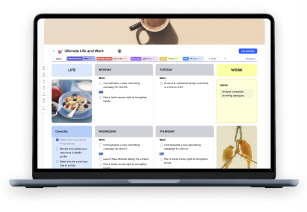Project brief is considered as the core document laying the objectives, scope, and parameters of the project. This is like the blueprint guiding the team’s effort, ensuring that everyone does his part toward a common goal.
Everyone knows this, but not everyone sticks to this. Why? Mostly, because they grew tired after each mundane brief. How can one resolve it making the process of creating a brief a breeze? Use new ways and xTiles to make everything quick, clear, and beneficial.
In this article, we’re going to learn all the tips and tricks to create a great project brief. Also, we will take a look at some worth attention pitfalls and shortcuts to get your brief done without a hassle.

What is a good project brief?

Project brief is that document which takes into consideration all the drivers of the project, the purpose of the project, the objctives, the deliverables, and constraints. All the stuff people usually don’t like, but can’t execute a project effectively without.
It has to be sufficiently detailed in a way that no ambiguity or confusion is left at the end of it and has to provide a common understanding of what is to be done and how completion will look like.
A good project brief will quite literally serve as a guide, being one that spells out at the outset what the project intends to achieve, the boundaries it is to operate within, and the outputs that are expected. It aligns the project team, manager, and stakeholders to one direction.
A good project brief has to be detailed, guiding the project team while at the same time allowing flexibility to change or adjust as the project develops.
It should also identify the target audience or end-users, what their needs are, and how the project plans to fulfill those needs. The brief should also detail success criteria of the project, which could detail quality standards, performance measures, or acceptance criteria.
In addition to the core elements, a good project brief may include additional details such as:
- A project timeline or schedule, including key milestones and due dates
- Task assignments and roles/responsibilities of team members
- Resource allocation, such as budget and staffing requirements
- Communication and reporting protocols
- Risk assessment and mitigation strategies
- Review and approval processes
A project brief informs clarity and brevity of this critical piece of information, which largely establishes an effective project planning, execution, and management framework. It aligns creatives, marketers, and stakeholders by setting out objectives, scope, and what is to be expected right from the onset of the project.
Project brief and other briefs

Project brief vs. creative brief
Both a project brief and a creative brief are important tools for design and marketing working process setup. Each one serves a different purpose and has a different content, yet they are bound, and in many cases, teams require both for managing projects effectively.
We already know that the project brief is a communication tool outlining the project’s scope, objectives, and requirements, providing direction to all participants and ensuring they work on the same concept.
Meanwhile, the creative brief might be irrelevant or at least not interesting to the whole team. Normally, it assists the creative team that is responsible for the visual and conceptual outputs of a project.
This kind of brief covers details about the project description, brand personality, tone of voice, key messages, and visual orientation. The creative brief ignites inspiration among creatives while ensuring they understand the brand’s core message and desired emotional impact on its target audience.
Project brief vs. project plan
We already know what a project brief is, so to save time, let’s go directly to a project plan.
A project plan is a comprehensive and very detailed (the more details it contains, the fewer questions and doubts likely to arise during execution) document that outlines the specific tasks, timelines, resources, and strategies required to turn a project into a success. In other words, it is a roadmap for the project team. It ensures everyone understands their roles, responsibilities, and deadlines.
While the project brief provides an overview and sets the direction for the project, the project plan is a more granular document that outlines the specific steps and processes required to achieve the project’s objectives. In this case, we can consider a project plan a more detailed and specific branch of a bigger document – a project brief.
Needless to say, both documents are essential for effective project management, as they help teams to clarify all aspects of their projects, align their responsibilities with their capacities, and provide a structured approach to achieving project success.
Project brief vs. executive summary
An executive summary is a compressed, high-stature view of a more comprehensive document or report: a project proposal, a business plan, or a feasibility study. In principle, it is a distillation intended to quickly inform the most important elements of the document (project background, objectives, proposed solution, and major advantages) to those responsible for decision-making.
An executive summary generally needs to be very brief, frequently not more than one or two pages, and is meant to be an eye-catcher at best and to be persuasive enough for the reader to seek more information in reading the entire document.
Differences between a creative brief, project brief, project plan, and executive summary
Knowing the differences between all these documents is important for effective execution. It helps you know what your team needs to start their job and ensures smooth and on-time delivery. We prepared a small infographic you can use as a cheat sheet whenever you’re unsure what to do.

Why is a project brief important?

Without a doubt, the project brief is among the most important prerequisites for success in a project of any scope and complexity. A well-constructed project brief is the basis for good and competent project planning, execution, and management; it provides many advantages that contribute to the success of the project.
Alignment
The project brief provides a shared understanding and vision among all team members, project managers, key stakeholders, and the creative team of the purpose, scope, and expected outcomes of the project, thus minimally reducing the possibility of misalignments or conflicting priorities.
Clarity and focus
The brief clearly outlines the objectives of the project, deliverables, target audience, and requirements in a way that scopes creep or there is unnecessary deviation from the project’s goals by the project team.
Resource allocation
This project brief offers an effective way of allocating resources with regard to the project requirements, timeline, and budget. This ensures project success by allowing the concerned personnel and stakeholders to make the proper resource allocations for personnel, equipment, and funding required for successful completion.
Accountability and responsibilities
It briefly articulates the roles, responsibilities, and success criteria of every team member and stakeholder involved. Therefore, this will bring a sense of accountability to assure that the owner of a task understands all the rest of the items falling under him and their contributions to the larger success of the project.
Communication and collaboration
The project brief acts as the central reference document that instigates effective communication and collaboration between team members, project managers, and stakeholders. It gives them a common language and common understanding, hence enabling coordination and knowing what stage is at.
Risk mitigation
The well-structured brief has to outline in the upfront the possible risks, constraints, and assumptions. In this respect, the project team is able to avoid and thus, by all means, reduce proactively, therefore minimizing the chances of delays, budget overruns, or even project failures.
Stakeholder buy-in
The project brief is very useful in trying to get stakeholder buy-in and support. It outlines the objectives of the project, benefits, and expected outcomes of the project in clear terms, thereby letting the stakeholders understand the value and importance of the project; in so doing, this increases their engagement and commitment.
Creating clear project briefs
Now the most interesting and yet simultaneously complicated part is that we use all this knowledge on the project briefs and come up with our own. You might even be one of the managers responsible for creating such documents and, perhaps, you would want to save your experience for further usage, in the form of a project charter or project brief template, which would work particularly for your niche.

Project Overview
The Project Overview section is essentially an executive summary that provides a high-level overview of the entire project. It should be concise yet comprehensive, giving stakeholders and the project team a clear understanding of the project’s purpose, goals, and expected outcomes.
It is just in this first part that one may take quite a long time, because they do not know what to do, where to go, how to structure the data they have, etc. For the x type of issue, we recommend using pre-designed templates such as the xTiles Project Overview Template. This will help you get started with the project overview, not mentioning the whole brief, even if you are sure about every single detail.

Start off by stating the name of the project and a brief description of the entailed details. These may be about a single sentence long or a paragraph long, basing on the complexity of the project.
Project goals and objectives. This is a specification of the organizational set objectives, and they should be in line with the strategic objectives of the organization. Articulate what the project is meant to achieve explicitly and the desired outcomes.
If relevant, include a high-level project roadmap or timeline with key milestones/phases. This would allow the stakeholders insight into the scope and/or duration of the project.
Include a creative brief for creative projects or marketing campaigns. The creative brief should outline the overall creative direction of the project, target audience considerations, messaging ideas. xTiles can be helpful in this case, too. You can use our Creative Brief Template and develop, structure, and communicate your ideas easily.
And the final one, do not forget about your budget, as this may be a really crucial factor in the whole process.
Scope and deliverables

Determination of the project’s scope is very important; it helps in defining the boundaries of the project and explicitly pointing out what is included and what is not included in the project. The following are what the project’s boundaries will include and what they will exclude.
First, provide a high-level overview of the scope of the project. This should align with goals and objectives as outlined within the Project Overview section.
Next, detail a listing of all expected deliverables for which the project team would be responsible. The deliverables could take the form of:
- Reports (market research reports, feasibility studies, performance analyses)
- Prototypes (product prototypes, website mockups, software demos)
- Marketing campaigns (advertising campaigns, content marketing initiatives, social media strategies)
- Technical documentation (user manuals, system specifications, API documentation)
- Training materials (employee training programs, customer onboarding resources)
- Implementation plans (project rollout strategies, change management plans)
Give a clear description of each deliverable, its purpose, its audience, and special requirements or guidelines. It will help ensure the project is actually living up to what the stakeholders expect and certainly corresponds with the scope of the project that has been defined.
Clearly outline and describe what is not included in the scope of the project. This is to ensure that the expectations and deliverables of the project are well managed and there are no misunderstandings. For example, in a project to develop a new product, marketing and sales efforts are not part of the scope.
Stakeholders

Identify all key stakeholders for the project, including clients/sponsors, end-users/target audience, project team members (project manager, marketing experts, creatives), and relevant organizational stakeholders (marketing, sales, product, customer support, leadership).
For each stakeholder, outline their role, responsibilities, decision-making authority, requirements, and preferred communication methods. For marketing projects and campaigns, consider external partners (agencies, influencers, media), legal/regulatory requirements, and brand guidelines.
Thoroughly understanding stakeholder roles, needs and involving them from the outset ensures effective collaboration, clear communication, and alignment throughout the project lifecycle.
Timelines

Set a realistic project timeline with clear start and end dates. Break it down into manageable phases or stages (e.g., planning, development, testing, deployment). Set the time frame of all major milestones, review points, and final delivery or completion.
Set realistic deadlines keeping in mind the amount of required effort, dependencies, resource constraints, and buffer time. Visualize the timeline using a Gantt chart or project management software.
Review and update the timeline periodically while making stakeholders aware of such changes. A clear timeline allows for better planning and, through the appropriate allocation of resources, will result in timely delivery.
Roles and responsibilities

Make clear the roles and responsibilities of all actors involved, from the project manager, the subject matter experts, the developers, and the designers to any outside contributors.
Specific tasks, areas of accountability, and decision-making authority for each role without overlapping or leaving gaps. Details, especially in expertise, experience, and capacity for the project that guide key role definitions. Align responsibilities with the strengths and availability of the individual.
Maintained and updated roles regularly as needed, adjusting to changes in project scope or resource availability.
Success criteria

Define the exact and possible criteria by which the success of the project can be evaluated. These have to be in line with the objectives outlined and meet stakeholder expectations. Quality criteria may include quality standards, performance metrics, user acceptance testing, return on investment goals, and delivery timelines.
Establish mechanisms to monitor and report on progress throughout the project lifecycle against success criteria.
When changes in the project scope happen, criteria are reconsidered and realigned with the new set goals.
Context and background

Provide the relatable background, existing data as results of prior research, and other works, that will help inform what direction shall be taken in executing the project. This could be the driving organizational driver, findings from a previous related project, market trends, or otherwise user insights and competitive analysis.
Highlight the major challenges, opportunities, or constraints that necessitated this project to have been initiated. The Business Case: Strategic Objectives or Desired Outcomes Driving the Need for this Project.
Assumptions and constraints

Identify any assumptions made during project planning that might affect scope, timelines, or outcomes. Then, outline potential constraints or risks such as budget limitations, resource availability, technical dependencies, or regulatory requirements.
Assumptions and constraints are categorized as internal (within the organization’s control) or external (outside the organization’s control) factors. The relative likelihood that any of the assumptions or constraints would actually occur and the severity of its impact on the project’s success is.
Develop mitigation strategies or contingency plans for the major risks. Always review and make the assumptions and constraints updated. Documented assumptions and constraints clearly should be available to enable the pro-active management of risks and make decisions on the same, informed.
Communication and reporting

Clearly define the communication protocol on the project status, update frequency of issues, and escalation to the stakeholders with the respective stakeholders. Clearly articulate the frequency of communication and communication channel to all the identified audiences through meetings, reports, or collaboration tools.
Define the format and template for the status reports that clearly show the highlighted milestones, risks, and blockers. Establish clear escalation paths dealing with critical issues and changes affecting the project scope, timeline, or budget.
Effective communication and reporting makes communication transparent, the project runs on the projected scope, ensures delivery by retaining time and cost targets, stakeholder alignment is maintained, and decision-making becomes timely and effective.
Review and approvals

Identify in detail who will be the responsible stakeholder or members of the executive team who overlooks the review and final approval of the project brief, plans, and deliverables, including major changes. Clearly define the approval processes, including review cycles, mechanisms for feedback, decision criteria, and deadlines, in such a way that.
Require sign-offs on key milestones, changes to the scope or budget, or changes in any way to the original plan. Adopt formal change control that documents, assesses, and approves alterations. Coordinate reviews, address feedback, and facilitate approvals with appropriate roles.
Review and approval processes are very often defined with some kind of stakeholder alignment and governance standards maintained, with smooth transitions between phases enablement. Clearly outlining these protocols ensures transparency, accountability, and a structured approach to managing changes securing buy-in throughout execution.
Summing up
It goes without saying that the effectiveness of the project brief is pivotal in ensuring success in just about any project, since it establishes shared understanding and alignment of stakeholders, and sets the execution base. This paper, therefore, guides one on best practices to be followed in order to write complete briefs that never leave any room for ambiguity and misunderstanding.
All fine and well, but the quality and consistency of project briefs has to be top-notch. This is a pretty dull and time-consuming task, especially if you are a project manager with more than one project on your plate. Tools like xTiles can make this part of the work much easier.
xTiles is a powerful, visual, collaborative platform for creating reusable templates and patterns with which to dress your project briefs. Streamline how you put your brief together with xTiles, it does this by offering you predesigned templates that the company identifies as streamlining your process for Project Overview Template and Creative Brief Template.

FAQ
Why is it important to have a project brief template or pattern?
This means work will be able to get a systematic time-saving, proven starting point with the help of a reusable project brief template or pattern to build on past success. In so doing, it will ease the art-making process and ensure a full brief is done with the mitigation to overlook the critical details.
How can xTiles help with creating project briefs?
xTiles includes pre-designed templates such as Project Overview and Creative Brief templates used in the article. If required, one can save their created designs as a custom template and reuse them accordingly in their organizational needs. xTiles: Leverage the collaborative capabilities of xTiles to easily collect feedback from your stakeholders.
What are the key elements that should be included in a project brief?
Key elements include project overview, scope and deliverable, stakeholders, timelines, roles and responsibilities, success criteria, context/background, assumptions and constraints, communication protocols, review/approval processes. This ensures the strategy of alignment, clarity, and a structured approach.








